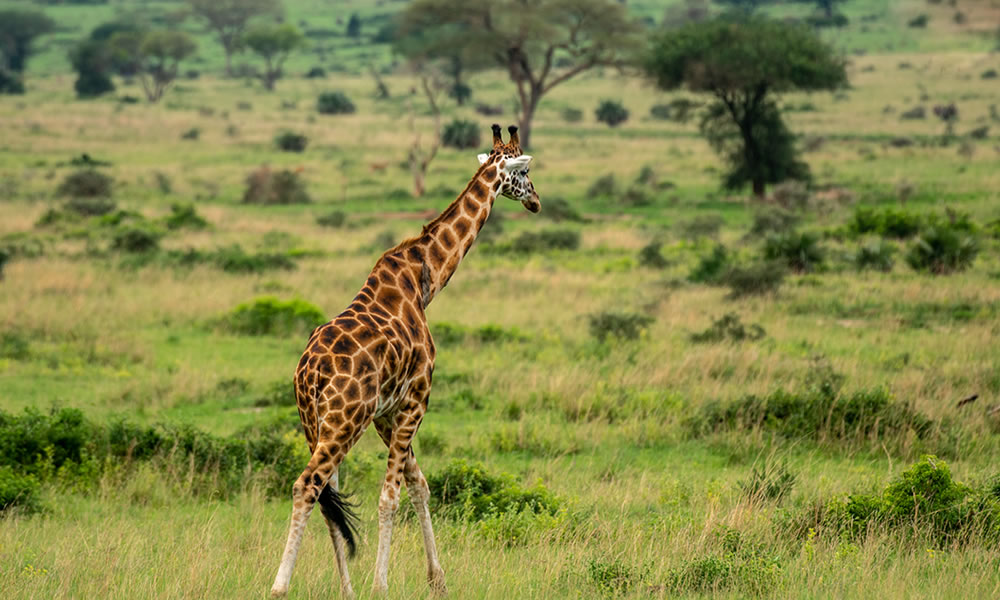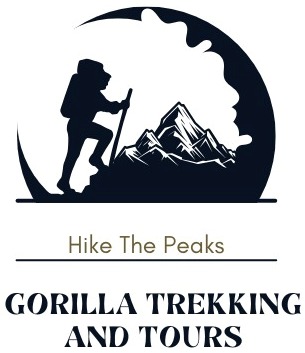Murchison Falls National Park is the largest park in Uganda, with 1,503 square miles in total area. In northwest Uganda, it is found in the districts of Kiryandongo, Masindi, Nwoya, and Buliisa. The River Nile, which also produces breathtaking waterfalls, splits the park in half. The British explorer Sir Samuel Baker was so taken by one of the park’s waterfalls that he dubbed it Murchison Falls, a name the park later adopted.

The majority of Murchison Falls National Park is made up of open plains, ponds, woodlands, and Savannah grasslands. The park is part of the broader Murchison Falls Conservation area, which also includes the Karuma Falls and Bugungu Wildlife Reserves. There are big forests like Budongo, Rabango, and Kaniyo Pabidi. Kaniyo Pabidi has large ironwood and mahogany trees. All three woods are home to a variety of bird and ape species, including olive baboons, blue monkeys, chimpanzees, and black and white colobus monkeys.
The greatest concentration of Roskilde Giraffes and crocodiles in Uganda can be found in the Murchison Conservation Area. With 76 different mammal species and over 445 bird species, the park serves as a lion conservation unit. Many mammals were lost during the Idi Amin dictatorship in the 1970s as a result of unchecked poaching and hunting for meat and sport. Despite efforts to reintroduce them from the Ziwa Rhino Sanctuary next to the park, the few white rhinos that once roamed the area were all but wiped off.
Despite the Uganda Wildlife Authority’s best efforts, poaching is a common habit in the park, albeit on a minor scale, mostly for bush meat. The 1990s Kony conflict in Northern Uganda had an impact on the park as well, with some nations forbidding their citizens from visiting. Since 2005, there has been a notable growth in tourism and peace has returned to every corner of the nation. The Savannah grasslands, the Nile River, the Murchison and Karuma Falls, and the woods of Budongo, Rabongo, and Kaniyo Pabidi are the main draws.
Things to do in Murchison Falls National Park
Game Drives
This is possibly the best thing to do in the park. While it is possible to go on game drives alone, it is a more instructive experience to have a park ranger accompany you. They may assist in identifying various bird and mammal species or point you in the right direction. During your three-hour game drive to Murchison Falls, you can witness animals such buffaloes, crocodiles, elephants, giraffes, hippopotamus, leopards, lions, monitor lizards, side-striped jackals, spotted hyenas, and warthogs.Bohor Reedbuck, Bushbuck, Defassa Waterbuck, Hartebeest, Oribi, and Uganda Kob are a few of the antelope species that can be seen in Murchison Falls National Park during a safari.
Among the primate species present in the park are baboons, Vervet monkeys, Black and White Colobus, Patas monkeys, and chimpanzees in the Rabongo and Budongo Forests. The park is home to a variety of smaller snakes, mambas, cobras, and African rock pythons.
Visiting the Top of the Murchison Falls
Most people start their trip by going to the top of the falls. As the Nile River winds its way into Egypt, it falls through a small valley, creating the Murchison Falls. After the Victoria Falls, it is considered one of the world’s most powerful waterfalls. While travelling with a group or someone who is familiar with the area is advised, a guide is not necessary to reach the top of the falls. Amazing is the first view of the falls from the summit. One of the most amazing sights to behold while visiting the park is the deafening sound of the water crashing through the gorge and plummeting 42 metres below. The mist resulting from the force of the water combines with the suns raise to form spectacular rainbows which are awesome to watch.
Boat Cruise at The Bottom of The Falls
Like the launch cruise at Queen Elizabeth National Park’s Kazinga Channel, this is one of the most popular things to do while visiting the park. The trip begins and ends at the base of the falls and lasts approximately three hours. The view of the waterfall and the thunderous roars of the water tumbling down to the river is magnificent from the top of the falls. There is a plethora of wildlife in the Nile region beyond the falls, including some of Africa’s largest populations of crocodiles and hippos. Elephants, buffaloes, and several antelope species can all be seen drinking at the river’s edge. The water birds include bee-eaters, cormorants, ducks, fish eagles, herons, kingfishers and shoebill Storks. After taking photos and seeing enough of the birds and animals, the captain will turn the boat upstream to bottom of the falls for visitors to disembark and climb up to level ground.
Boat Ride to the Nile Delta
The point where the River Nile joins Lake Albert is known as the Nile Delta. Going upstream beyond the point where the boats used for the regular cruise turn is part of the boat voyage to the Nile Delta. This is a must-do activity for birders and will take half a day. Typically, tourists go down the Nile in a boat until it enters Lake Albert. More creatures gathering to drink along the Nile’s banks and birds at the papyrus swamps surrounding Lake Albert can be spotted en route to the lake. Numerous bird species, including the endangered shoebill stork, can be seen in the vicinity of the Nile Delta.
Rhino Tracking at the Ziwa Rhino Sanctuary
The Ziwa Rhino Sanctuary is situated on the route from Kampala to the Murchison Falls National Park. Rhinos are no longer able to traverse Uganda’s national parks due to widespread poaching. The Ziwa Rhino Sanctuary was created to safeguard the remaining rhinos and carefully breed more of them, with the goal of relocating them to larger parks once their population reaches 20. The primary activity here is foot rhino tracking, which is typically overseen by sanctuary rangers. The Rangers provide information on rhinos, the sanctuary’s past, its breeding programme, and broader conservation initiatives. They then take guests on a close-up look at the enormous creatures while they eat. The large sanctuary is home to a variety of bird species as well as small primates besides rhinos. Additionally, nature trails are available for visitors to witness birds like the Shoebill Stork. All admission fees are donated to rhino conservation initiatives.
Fishing
One of Uganda’s greatest locations for fishing is the region beneath the Murchison Falls. In this section of the Nile, one can still catch enormous Nile perch that reach more than 200 pounds. Tilapia and tiger fish are two more often obtained species in this area. Visitors can stand at the base of the Murchison Falls and through their line, or they can go fishing on the Nile by boat. You can also go fishing at one of the riverbank pools or the Karuma falls. It is required of guests to obtain a fishing licence and to carry their own equipment. Smaller fish must be first caught and used as bait in order to catch Nile Perch.
Guided Nature Walk
These forest hikes can be done in Chobe, or better yet, in the Rabongo and Budongo forests. They are appropriate for educational reasons. Numerous bird species and primates like chimpanzees and monkeys can be found in these two forests. An expert guide or ranger who is familiar with the many bird, tree, and animal species should lead the hikes.
Bird Watching
In Uganda, Murchison Falls Park is among the top locations for birdwatching. Either a safari vehicle or one of the nature walks can be used for this activity. The Murchison Falls is a sizable park that offers a wealth of locations and chances for birdwatching. It might begin directly outside your lodge and proceed to the Savannah grasslands, woodlands, and the Nile River. Adventures in the Murchsion Falls National Park Kaniyo Pabidi Forest Area is another place to go birdwatching. Abdim’s Stork, Abyssinian Ground Hornbill, African Darter, African Fish Eagle, African Jacana, African Quail-Finch, African Skimmer, Bar-breasted Firefinch, Beautiful Sunbird, and Black Crake are a few of the bird species found in the park.
Chimpanzee Trekking in Budongo Forest
Situated to the south of the park, Budongo Forest is a component of the Kaniyo Pabidi and Budongo forest reserves. More than 464 plant and mammal species, including more than 820 chimpanzees, can be found in the forest. Since Jane Goodall has a research station in Budongo Forest, chimpanzee tracking is the most popular pastime there. Tracking chimpanzees begins at 8 a.m. and finishes at approximately 3 p.m. Although it may depend on the time of year, there is a good chance of sighting the chimps. The best months to see the chimps are May and August. Trackers should never become bored with their activities, even if this magnificent forest is home to over 360 different species of birds and smaller primates, such the black-and-white colobus, blue monkey, forest galago, pattos, and red-tailed monkeys. Usually, a competent and experienced guide leads the tourists to help them recognise different species of animals, plants, and birds.
Hot Air Balloon Safari
Murchison Falls is the only park in Uganda that provides hot air balloon safaris. To start this workout, the balloon is gathered and inflated early in the morning. Before leaving, guests are given a safety briefing after that. There are opportunities to view and take pictures of the woodlands and wildlife from above throughout the about hour-long excursion. It’s an incredible experience to fly above massive herds of antelopes, elephants, buffalo, giraffes, and other carnivores coming in from the hunt at night. Upon completion of the excursion, travellers report seeing more animals than they did on their typical game drives. After the exercise, participants are entitled to a certificate of participation. Dream balloons is the firm in charge of organising the balloon safari, but the Uganda Civil Aviation Authority is in charge of oversight.
Camping
Although camping is permitted inside the lodges, it is preferable to camp in a wilderness or forest, such as Kaniyo Pabidi. Tents, water, and firewood are given to campers. Although you can purchase food and equipment in advance from your resort or the park officials, you might need to pack your own.
